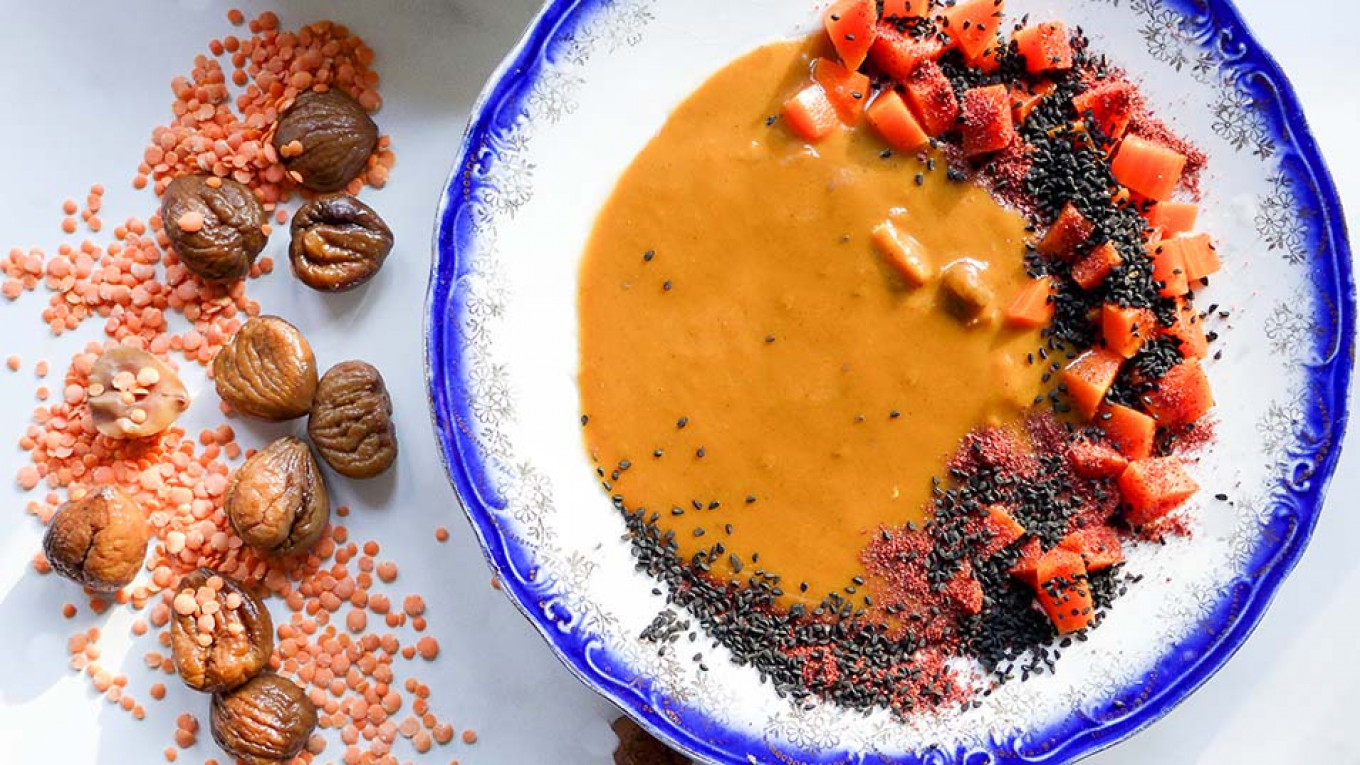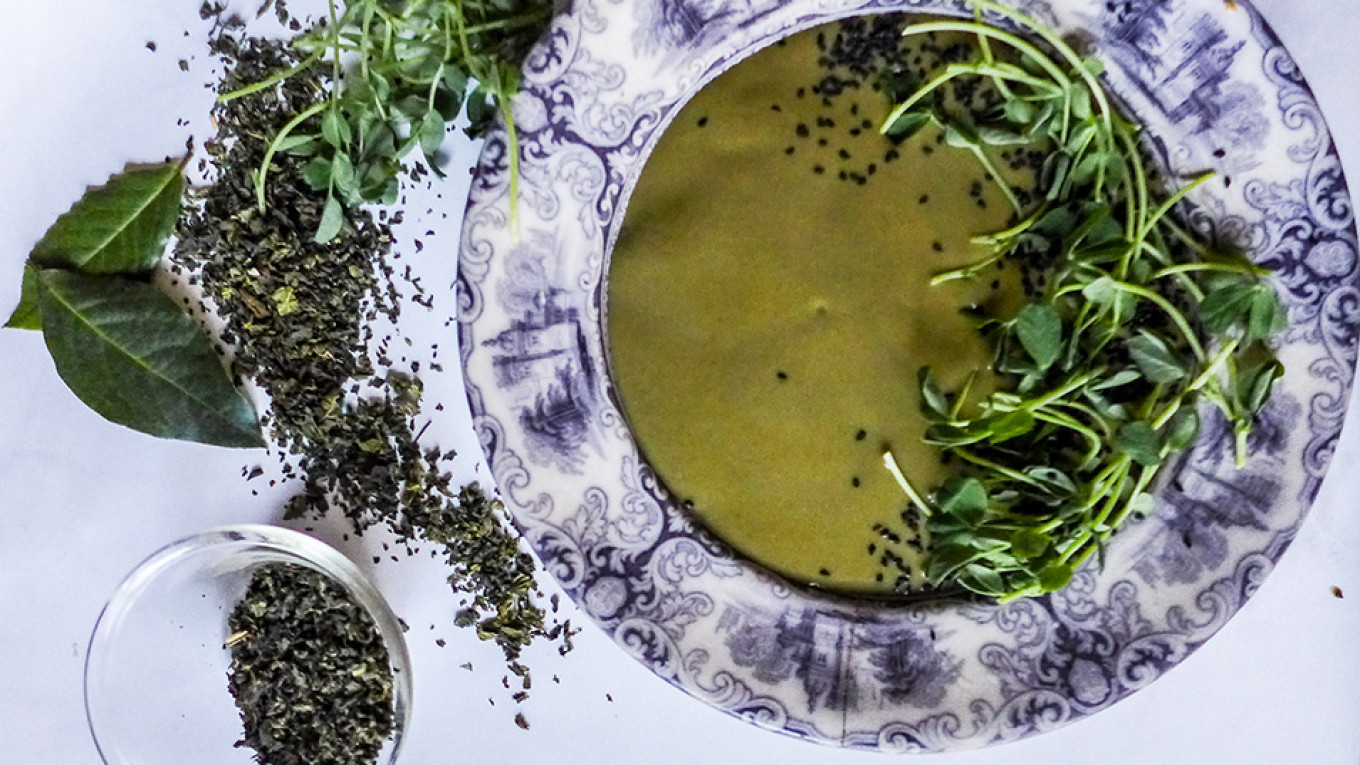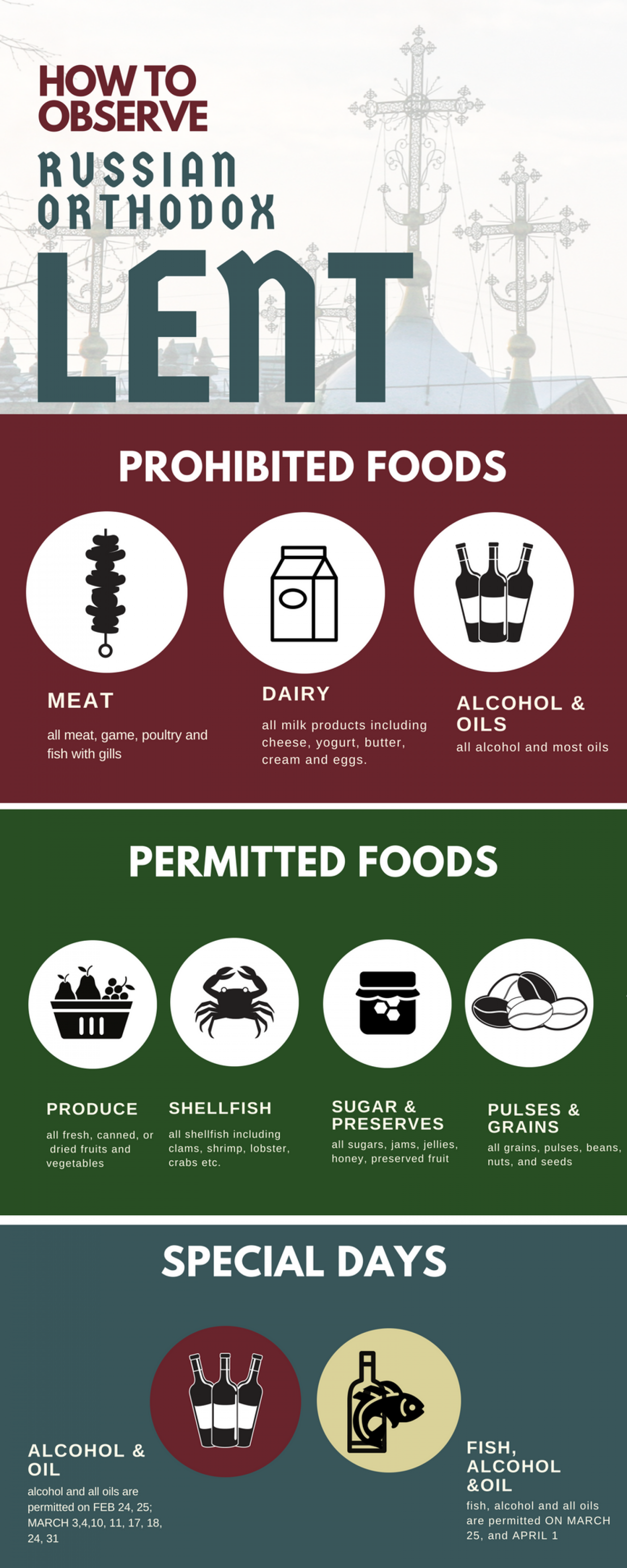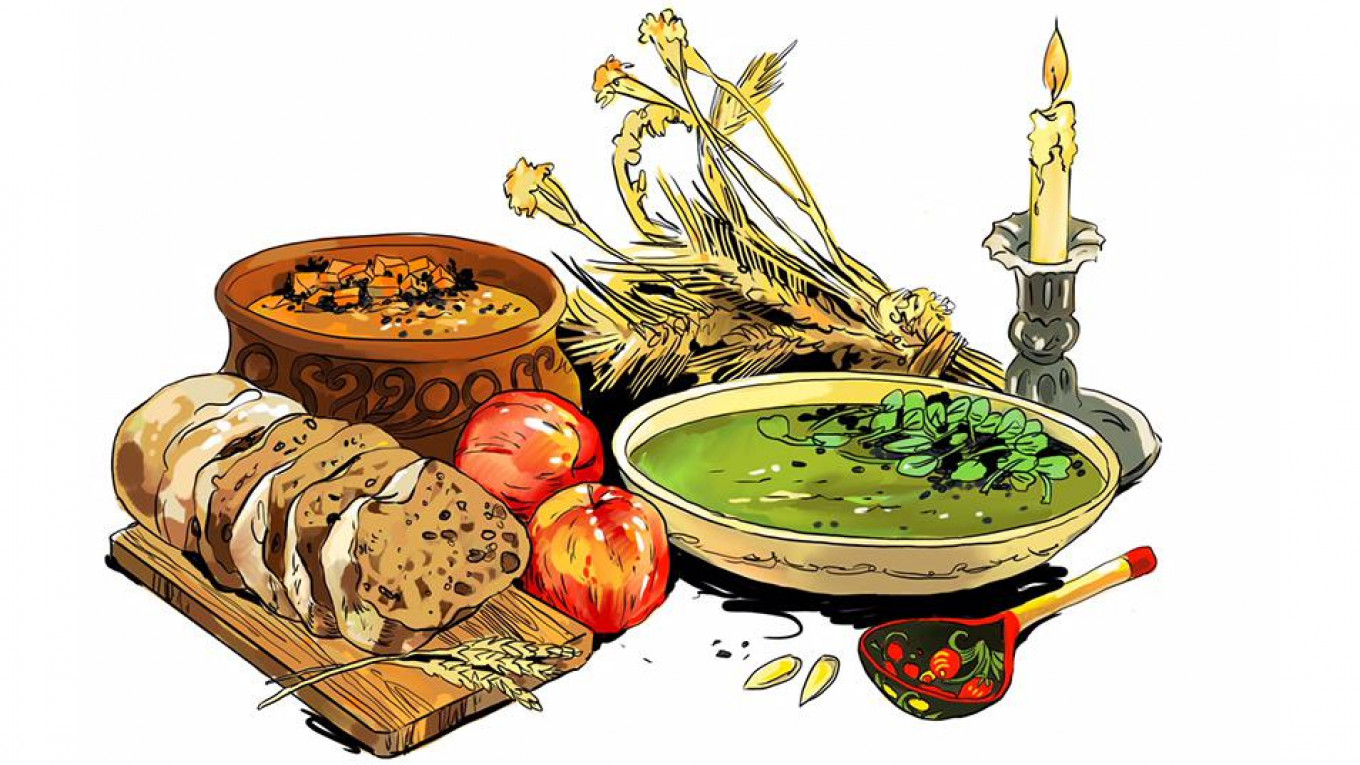“What are you giving up for Lent” is the wrong question to ask a Russian Orthodox Christian.
They don’t get any say in the matter: what they give up is imposed upon them by a bunch of men with white beards. And that list is so very long that few can recite it off by heart.
But I can.
For forty days, the Orthodox faithful forego all meat, including fish (with gills), game, and poultry; all dairy, including eggs; all alcohol and most oils. You get the occasional time off for good behavior (see the infographic) when you can have some alcohol and some oils, and I highly recommend an X-large portion of McDonald’s French fries and a Jeroboam of chardonnay on these days. All other days, though, you have to eschew the entire list.
“That’s like all the food groups,” I hear you cry.
Not all. All fruits and vegetables are permitted, as are pulses, grains, nuts, and seeds, shellfish, and to the chagrin Roman Catholics everywhere, sugar, honey, preserves, and jellies.
“So okay,” an Orthodox priest friend of mine once explained to me, “You could, in theory, have Lobster Thermidor in drawn margarine; but that’s not the point.”
The point, of course, is to emulate Jesus’s forty days roaming the wilderness, during which time he resisted the many temptations of Satan, and after which he came out of the wilderness and began the ministry that ultimately led to his crucifixion. I mention this because I have encountered many a demonstrably devout Orthodox Christian who can’t connect those dots.
As a culinary historian, I’m also more than a little convinced that there is an agricultural aspect to “Great Lent” (as it is called to distinguish it from the myriad of smaller fasts that happen with alarming regularity throughout the liturgical year). Call me cynical, but I think the powers that be were very clever to schedule Lent to coincide with the period when 98 percent of the illiterate and poverty-stricken population was trying to eek out their dwindling winter stores of root vegetables and grains. It helps to have a side dish of spiritual underpinning to your incredibly meager and bland diet while you wait for it to warm up so the cows can calve and you can finally have butter again.
“Not the point,” my priest friend would remind me.
Observing Great Lent has become fashionable in recent years as Russia has once again embraced religious observance. It’s become so mainstream that even non-believers see it as a way to kill two birds with one stone: ascend a higher moral ground and shed 5-10 kilos at the same time.
Many of my husband’s friends (a group as unfamiliar with the fundamental values of Christianity as they are with the principles of good taste) take up Great Lent with noisy enthusiasm. It’s uphill work trying to cater for them. Without butter or oil, it’s tough to get past the first three lines of most recipes. The no eggs thing makes it almost impossible to bake, and no alcohol makes an evening with my husband’s Orthodox friends seem as long as Lent itself. But I like a good culinary challenge, and Lent is undoubtedly that.
It’s a slippery slope to try and make Lenten food seem either “normal” or even “glamorous.” That is definitely not the point, and whenever I’m in danger of forgetting this, I need only recall an aspiring food blogger who kept an interesting online Lenten diary a few years ago. It was not un-interesting, and she was chugging along with it (you could sense the book proposal shaping up nicely) until she hit Week 5 (when many hit the brick wall) and her 6-year-old’s birthday. Instead of letting the kid off the hook for one day in 39, this intrepid food blogger forged blithely ahead and made a vegan birthday cake with tofu, and to add insult to injury; she stuck about three packets of wooden toothpicks in so it would look like a hedgehog. Then she photographed it.
This, to me, was certainly not the point. Frankly, she’d lost me at tofu, but the toothpicks were just too much.
I stick with the classics during Lent, which means a few things: pulses, grains, beans, and vegetables. Mushrooms constitute an entire food flank during Lent, as you can readily discern from the many Lenten menus that restaurants offer to their devout patrons.
The easiest way to get through Lent to my way thinking is by making a lot of hearty vegetarian soups, so here are two to help you over the hump and get your ready for Week 5.
My Lenten Lentil (try saying that ten times fast) Soup is a great way to get in a plethora of healthy vegetables, protein, and fiber. Chestnuts and roasted peppers give this soup a lovely creamy, velvety texture that most lentil soups lack, while the combination of spices gives it a beautiful depth of flavor.
Nettle Soup is my promise to you that spring is on its way. I love Russia’s sour, tangy foraged soups and I was feeling almost desperate for some stinging nettles one February. These prickly herbs are packed with all kinds of health benefits too numerous to list here, but to me, the great thing is the distinctive tangy taste they develop when cooked. Discovering a cache of dried nettles in my local grocery store, I took a chance and experimented. What a great decision that was! If you can get fresh nettles, then, by all means, use those, but don’t be afraid to try the dry.
Both of these soups are so favorable and filling that you might forget that they are Lenten.
Which, my priest friend would promptly remind you, is also not the point.

Lentil & Chestnut Soup
Ingredients:
- 3 cups (710 ml) red lentils
- 1 Tbsp margarine
- 1large yellow onion, finely minced
- 1 Tbsp sea salt
- ½ tsp cinnamon
- 4 garlic cloves, smashed
- 2 cups (475 ml) chestnuts, shells removed
- 4 large carrots, peeled and cut into a fine dice (1 cm)
- 4 stalks of celery
- 2 red peppers
- 1 Tbsp tomato paste
- 1 Tbsp sugar
- 1 punnet cherry tomatoes
- 1 Tbsp coriander seeds
- 1 Tbsp caraway seeds
- 1 Tbsp sumac
- 1 tsp smoked paprika
- 8 cups (2 liters) vegetable stock or water
Garnish:
- 1 Tbsp black sesame seeds and
- 1 Tbsp coriander seeds
- Fresh parsley
Instructions:
- Preheat the oven to 400 F (200 C)
- Wrap the diced carrots, cherry tomatoes, and red peppers in separate packets of tinfoil and roast for 20-30 minutes in the preheated oven. Set aside.
- Melt the margarine in a large, heavy-bottomed soup pot. Sweat the onions and garlic until they are limp. While the onions are cooking,lightly toast the coriander and caraway seeds in a skillet until their odors begin to amplify. Crush with a mortar and pestle and add to the onions along with 1 Tbsp sea salt and the cinnamon. Add the celery and cook for 2 more minutes.
- Add the lentils to the pot and stir to combine them with the onions. Cook for one minute. Add the tomato paste, paprika, and sugar and stir to ensure the paste coats the lentils. Add half of the roasted carrots, the chestnuts, the roasted red peppers and cherry tomatoes, and sumac. Cook for 3 minutes before adding the broth or water.
- Bring to just boiling, then reduce the heat to medium-low, cover, and let cook for 1 hour.
- Strain the soup through a colander, retaining the liquid. Use tongs to remove all of the chestnuts, tomatoes, and the peppers, and then divide the remaining solids into two. Add one half to the chestnuts, tomatoes, and peppers then puree these with the retained liquid in a blender or food processor fitted with a steel blade. Add the remaining solids to the pureed mixture along with the remaining roasted carrots.
- Garnish with toasted black sesame and coriander seeds and fresh parsley.

Nettle Soup
Ingredients:
- 2 large bunches fresh stinging nettles or 7 oz (200 grams) dried nettles
- 4 Tbsp margarine or butter
- 3 good sized leeks, washed and coarsely chopped
- 1 small celery root
- 4 celery stalks with leaves
- 2 medium-sized red potatoes, peeled and sliced
- 2 cloves garlic, peeled and grated
- 3 cups (710 ml) fresh spinach
- 1 cup (240 ml) chopped parsley
- 2 Tbsp chopped dill
- 8 cups (2 liters) chicken or vegetable broth
- Juice of one lemon
- A pinch of cayenne pepper
- A pinch of nutmeg
Optional (non-Lenten) garnish:
- 1 cup heavy cream or crème fraiche
- Substitute coconut milk to make this soup Lenten
Instructions:
- Melt the butter in a large heavy-bottomed pot. Add the leeks and sauté until they are limp (approximately 10 minutes). Add the nutmeg and a good pinch of salt.
- When the leeks are completely limp, add the nettles and toss gently to combine. Add the celery, celery root, garlic, and potatoes and cook over medium heat for 5 minutes.
- Add the broth and bring to a steady simmer. Reduce the heat, cover, and cook for 30 minutes.
- Remove from the heat. Add fresh spinach, parsley, and dill. Puree in a blender until smooth.
- Gently reheat and add the cream or coconut milk.

A Message from The Moscow Times:
Dear readers,
We are facing unprecedented challenges. Russia's Prosecutor General's Office has designated The Moscow Times as an "undesirable" organization, criminalizing our work and putting our staff at risk of prosecution. This follows our earlier unjust labeling as a "foreign agent."
These actions are direct attempts to silence independent journalism in Russia. The authorities claim our work "discredits the decisions of the Russian leadership." We see things differently: we strive to provide accurate, unbiased reporting on Russia.
We, the journalists of The Moscow Times, refuse to be silenced. But to continue our work, we need your help.
Your support, no matter how small, makes a world of difference. If you can, please support us monthly starting from just $2. It's quick to set up, and every contribution makes a significant impact.
By supporting The Moscow Times, you're defending open, independent journalism in the face of repression. Thank you for standing with us.
Remind me later.






